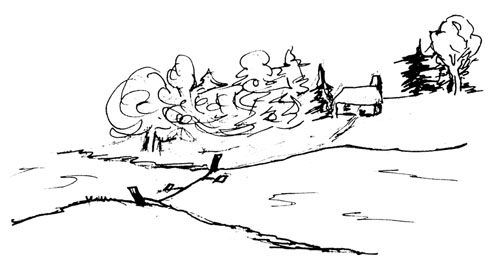|
Home : Quarterly Archives : Volume 20 |
Tredyffrin Easttown Historical Society |
|
Source: July 1982 Volume 20 Number 3, Pages 84–86 The Battle of Valley Forge Before you shake your head and shout, "Wrong, wrong - there never was a battle at Valley Forge!", hear my tale. Around 1735 a large-scale fishing business was developing in the Valley Forge area. It was threatening to monopolize the shad in the Schuylkill River. Every spring the largest and most palatable shad swam up the river in large schools. The fish were so numerous that they could be caught with nets, made of cord from wild grapevines. The nets were spread across the narrowest sections of the river. As their business grew, the enterprising fishermen looked for even better methods to catch their prey. Soon they were fencing the river and piling up huge rocks to form pools. When the shad run started and the shad arrived, the entire populace ofthe area came running to the river bank, carrying tree limbs, long handled shovels, and any other tool they could get their hands on. There they waded into the river, screaming and shouting and beating the water to scare the fish into the pools by the fence. The fish coming up the river to spawn were caught in such large numbers that they literally forced one another out of the water! Thousands were caught, without any difficulty. The work of gutting, salting, and packing them for winter consumption went on continually. All this activity did not amuse the upstream fishermen. Being pious Pennsylvanians and preferring peace to war, however, they kept their calm and sought a peaceful means to solve their problem. Accordingly, they drew up a petition to the Assembly, requesting that it outlaw fishing fences. The Assembly apparently favored the prohibition, but the Governor upheld the position of the downstream residents. In fact, he permitted fences to be built so high that navigation up the river during the shad season was impossible. The following year, in 1736, the petition again went to the Assembly. By this time, the Assembly had reversed its stand - but so had the Governor. He demanded that the fences be condemned. It was plain to see that this was just another squabble between the Governor and the Assembly. By 1738 the upstreamers had lost their patience with the due process of law, and resorted to more direct methods. Timothy Miller collected a flotilla of canoes, and paddled down stream just before the shad were due to arrive. Few Valley Forgers were on hand when Miller's angry invaders arrived to cut away the fences. The attackers hadn't been there long, however, before the Forgers found out what was happening and came out to rescue their fences. When Miller and his squad started to interfere with the locals1 salvage operations, a fight broke out. The Forgers launched their canoes and fought the invaders with clubs and poles. Miller's thumb was broken by a club. The Forgers chased the invaders into the Pickering Creek, drove their canoes a ground, and forced the upstreamers to flee into the woods. But this didn't end the battle. The upstreamers again sought legal action. Two constables, accompanied by three canoes of henchmen, again went down the river to destroy the fences. Two hundred abusive Forgers mustered for defense. One of the constables read a warrant, in the King's name, to keep the peace. The Forgers damned the King's laws and lawmakers, cursed the constable, and clubbed three oarsmen into the river, offering five pounds to have "a crack at Admiral Miller" himself. The constables and their entourage withdrew in haste. In the end, the peaceful Quaker spirit prevailed, and the problem was settled by compromise. The fences were allowed to remain, provided they were kept low enough to let canoes - and a few shad - pass on up the river. And so ended the fighting at Valley Forge. The shad run remained a big occasion along this part of the Schuylkill River for many years, as the shad here were not only plentiful, but exceptionally large in size. The "Bull" tavern was very near these fishing grounds, and was a popular spot at this time of the year. The fishermen gathered there well into the nineteenth century. By 1791 the shad had begun to deteriorate somewhat in size. Samuel Lane was innkeeper at the "Bull" at this time, and in order to keep the excitement alive he posted notice at his bar that he would supply whiskey to anyone bringing him an eight-pound shad. It wasn't long before he received his shad, sure enough weighing eight pounds. But when he cut it open, he reneged on his offer and broke the bargain: the fish had been stuffed with pebbles!
|
